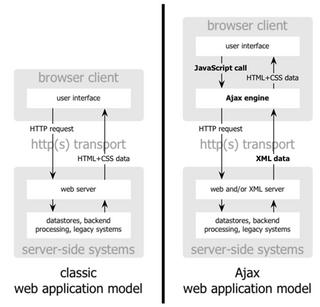Ajax !!!
.... I was wondering how Gmail behaves wonderfully compared to other mail providers. Today while googling, I came across the word Ajax, aka Asynchronous JavaScript and XML. It’s not a technology. It’s a combination of several, coming together in a powerful way. Traditional web applications work like this, the web server acts upon whatever was sent by the form, and then responds back by sending a new web page. A lot of bandwidth is wasted here. AJAX applications, on the other hand, can send requests to the web server to retrieve only the data that is needed, usually using SOAP or some other XML-based web services dialect, and using JavaScript in the client to process the web server response.
See how the Ajax model for web applications is working compared to the traditional model.

Instead of loading a webpage, at the start of the session, the browser loads an Ajax engine — written in JavaScript and usually tucked away in a hidden frame. This engine is responsible for both rendering the interface the user sees and communicating with the server on the user’s behalf. The Ajax engine allows the user’s interaction with the application to happen asynchronously — independent of communication with the server. So the user is never staring at a blank browser window and an hourglass icon, waiting around for the server to do something…
I got charged up... But why I am spending more time if it’s having nothing to do with .Net. So again my search engine started working. It ends up here. Yes… Microsoft has announced an AJAX based programming framework is being developed to provide asynchronous Javascript based callback for ASP.NET applications. This project, code named Atlas, will make use of existing callback features in ASP.NET 2.0 as well as new features such as multicast event handlers, new UI controls such as autocomplete text boxes, and a core framework of common functionality.
So we can wait for the AJAX era, but it doesnt mean we are going back to the purly client side programming.
.jpg)



0 Comments:
Post a Comment
<< Home